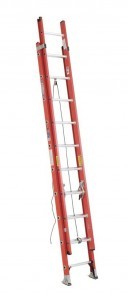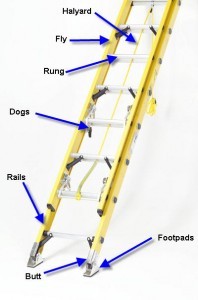We stopped by our friend Jim’s jobsite the other day. Jim, or Jimmy as we call him works for a very large construction firm in the Chicago area. As we started to talk, he mentioned how he had to yell at one of his workers for safety concerns. It seems this guy was more concerned about getting the job done quickly instead of safely. This worker put up a ladder on uneven ground, with the wrong angle. In addition, he didn’t have the right height. Worst of all, this guy wasn’t even an apprentice. He was a journeyman who has over 20 years of experience. Maybe he wasn’t thinking, or maybe he felt too safe, but either way, it was dangerous. After talking a while Jimmy wanted us to write a shorthand out that he could give to his workers at their morning safety meetings. We wrote a nice piece for them and got great feedback, so we decided to add it here on our website.
Before we get started we need to get down to some basics so we are all on the same page. First, let’s start with terminology. If you already know the terms, you can skip down to the next paragraph.
Butt or heel – Bottom end of the ladder, the end that is placed on the ground.
Dogs or Pawls – Device attached to the inside of the beams of the fly section used to hold the fly section in place after it is raised.
Fly – Upper section of an extension ladder, the part that is raised into the air
Footpads– Rubber swivel parts attached to the butt of the ladder
Halyard – The rope used to raise or lower the fly section
Rail – The two lengthwise members of the ladder beam
Rung – Cross members that provide the foothold for climbing.
Tip – Very top of ladder
(Click on picture to make it larger)
Some of the types of ladders are Single, Folding, Extension, Combination, Step and more, but these are the most common.
Before we get started you always want to do a quick check of the ladder to make sure neither the aluminum, fiberglass or wood is defective and causes the ladder to lose its integrity. You never know what has happened when you’re not around. Maybe a co-worker borrowed the ladder and then threw it on the ground when they were done, maybe your kids knocked it off the wall and didn’t want to tell you, maybe another contractor knocked it over and forgot to mention it to you. You just never know.
Before you, every lift or place a ladder, always look to see what might be above. Look for obstacles such as electric lines or anything else, don’t just raise a ladder without looking. Next, you always want to place the ladder on the even ground. If there isn’t any even ground, put a piece of plywood down to make your own level ground. Make sure the plywood is wide enough to make a difference.
We have a video below that illustrates how to set up a ladder, but a quick run down will also help. First, remember to always lift with your legs and not your back. If you are placing an extension ladder up by yourself, let the wall be your friend. Put the butt of the ladder where the ground meets the foundation and lay the ladder on the ground with the fly section down. Next, start at the tips and lift up. You can then grab the first rung and start walking the ladder up by grabbing the next rung and so on. With the ladder against the wall, it will not slide. Once the ladder is all the way up, walk the bottom of the ladder out while the tips rest against the structure. Your goal is to get about a 75-degree angle. One way to check is to put your feet at the butt and put your arms straight out, shoulder height. If your palms touch that rung , with your arms completely straight and no bends at the elbow, then the angle is fine.
When you are walking up the ladder don’t take to much stuff. If you have to make a couple of trips, then do it. Remember to always have three contact points with the ladder. Each hand and each foot are considered a contact point. So if you have nothing in your hands, you can walk up using the rungs. If you have something in one hand then you need to slide you hand up the rails without removing them.
-
If you have to work around electricity on a ladder, do not use an aluminum ladder, because it conducts electricity. Also don’t use a wood ladder that has lots of metal or a damp wood ladder. We all know electricity and water don’t mix.
-
If you are working next to a door, put an “Out of Service” sign up or let others know not to use the door. You can even leave it open, but you still have people walking around not paying attention, so you need to make others aware somehow.
-
On the job site, you should always be with someone else when working in high places, but if you are by yourself, tell a co- worker, or if at home let a family member know. Give them a time you should be done, that way if something happens, at least someone will get to you shortly.
-
When walking up a ladder, turn your tool belt around so it doesn’t snag on a rung and throw you off balance.
For home users only
-
If you are dropping tools on your folding ladder, put a bungee cord around the fold down section and put your tools under the to hold them tight, just remember to take them off before you fold up the ladder, so they don’t fall on your head.
-
On the top of your folding ladder, you can glue a magnetic strip to hold screws and nuts in place so they don’t fall off





Great review. I just signed up for your site and very nice. I printed this off for my employees for our Monday morning safety meetings. Great to go over the basics again.
i want to know about ladder how many types of ladder and what name
these are great reminders of basic safety things i often neglect, ha!
Ladder safety is a must for anyone and everyone. One small mistake, even just three feet up can have major consequences.
I like this